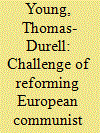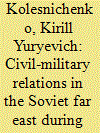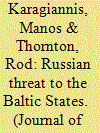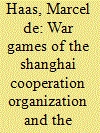|
|
|
Sort Order |
|
|
|
Items / Page
|
|
|
|
|
|
|
| Srl | Item |
| 1 |
ID:
147809


|
|
|
|
|
| Summary/Abstract |
This article posits four key challenges to address the question as to why logistics reform in Communist-legacy defense institutions has been so slow. First, what is the conceptual foundation for logistics in these countries? Second, what is the general state of national logistics capabilities in these countries? Third, why has the reform of logistics in these post-Communist legacy defense institutions been so slow and superficial? Fourth, in an attempt to understand the problem better, what do legacy defense institutions need to do themselves in order to be able to adopt modern Western logistics concepts? Conversely, what do donor nations need to understand about these legacy logistics organizations the better to enable them to understand the immense gap that divides Communist from Western logistics concepts? In addressing these questions, the author will argue two points. First, logistics reform has been impeded to date by a lack of appreciation on the part of particularly Western officials that legacy logistics concepts could not be more antithetical to their Western counterparts. Second, reform of legacy logistics organizations will not follow from attention and resources directed at tactical-level formations and importing the expeditionary logistics concept. Rather, the causation of the continued inability to adopt Western logistics concepts can be found in national-level policy, financing, laws, and regulations that continue to enable the operation of legacy concepts.
|
|
|
|
|
|
|
|
|
|
|
|
|
|
|
|
| 2 |
ID:
147812


|
|
|
|
|
| Summary/Abstract |
Primorksy Krai, in Russia’s Far East, provides a perfect example of the extreme need of cooperation between civil and military authorities during critical periods of conflict and potential wars. Ensuring this region’s defense capability and providing for the needed manpower for agriculture and needed industries resulted from the cooperation of civil and military authorities. This article is based on documents and materials researched in five Russian archives.
|
|
|
|
|
|
|
|
|
|
|
|
|
|
|
|
| 3 |
ID:
147810


|
|
|
|
|
| Summary/Abstract |
The article consists of the author’s observations while being assigned to the U.S. Embassy in Kyiv. The key points covered are the cause of the EuroMaidan Revolution, protester tactics, and a summary of the situation as of May 2014. It is written first-person and without citations
|
|
|
|
|
|
|
|
|
|
|
|
|
|
|
|
| 4 |
ID:
147815


|
|
|
|
|
| Summary/Abstract |
This article has been compiled on the basis of documents from French, German, and Soviet archives and reconstructs the history of the Legion of French Volunteers Against Bolshevism (LVF) in 1941. Often neglected or scarcely mentioned, the 638th Infantry Regiment was the only formation of the Wehrmacht that took part in the advance on Moscow. Undertrained, poorly equipped, and torn by inside political rivalries, the regiment still marched to the front and fought the Red Army in December 1941. Being almost destroyed, the formation was then withdrawn and thoroughly purged and reshaped by the Germans, who wanted to gain more from the collaboration with the Frenchmen. The experience of 1941 thus constitutes the first — even if unsuccessful — stage of this collaboration, both military and political, that dragged on until 1944.
|
|
|
|
|
|
|
|
|
|
|
|
|
|
|
|
| 5 |
ID:
147814


|
|
|
|
|
| Summary/Abstract |
The author suggests historical and textual comment to the most important reports of Russian chronicles, including those about the capture of Chernigov, reconciliation of the Russian princes with the Tatars, the coming of Möngke Khan to Kiev, Mikhail Vsevolodovich’s flight from Kiev, the capture of Kiev, Volodymyr Volynskyi, Berestie, and Halych. The significance of the Mongols’ stone artillery in attacking Russian cities is considered. The author compares various reports in Russian chronicles about the date of the capture of Kiev by the Mongols with information from Hungarian sources and concludes that the most trustworthy date must be 6 December 1240. Proper names Uladmur and Uchogul Uladmur given by the medieval Persian historian Rashid-ad-Din in his account of the conquest of South Rus’ by the Mongols cannot, in the opinion of the author, be related to the historical toponyms of Galician-Volhynian Rus’. The Mongol name Uladmur was connected with the name of Prince Vladimir Riurikovich, who had occupied the Kievan throne not long before the attack of the Mongols against South Rus’ and held peaceful negotiations with Prince Möngke. Based on the study of comparative-historical materials, the author concludes that in Volhynia and Galicia the Mongols used a method that they had often used before. They forced the residents of the conquered cities to go outside the city walls and massacred them. They spared only the young men suitable for military service and took them into auxiliary troops (khashar), so that they should fight in the most dangerous areas of the battle.
|
|
|
|
|
|
|
|
|
|
|
|
|
|
|
|
| 6 |
ID:
147808


|
|
|
|
|
| Summary/Abstract |
This article examines the responses made by the Baltic States to the threat they face from Russian hybrid warfare. It looks first at the nature of this threat and at the many modes of warfare that are being employed by Russia, including, and in particular, information warfare. The article then goes on to examine the way in which this threat is viewed in the Baltic States and the debate over how it can best be countered. Raising defenses, though, as is made clear here, is not easy. Indeed, this article argues that the defenses that are being raised by the Baltic States will prove largely ineffective and possibly counterproductive.
|
|
|
|
|
|
|
|
|
|
|
|
|
|
|
|
| 7 |
ID:
147813


|
|
|
|
|
| Summary/Abstract |
The article is devoted to an analysis of the attitudes of the different social groups of Russian society toward the Russian-Turkish war of 1877–1878. The author based her analysis on the memoirs, diaries, and epistolary heritage of contemporaries. The author reveals the attitudes of Russian society on the eve of and during the war. The author emphasizes the support of the war by the Russian peasants and the common people, who expressed their deepest sympathy to the suffering of the South Slavs under the Turks, as their brothers in faith. The author gives the analysis of the attitudes of the Russian nobility and the clergy toward the events in the Balkans. According to the author, the attitude of the nobility was controversial and also included personal motivations. The author reveals the opinions of contemporaries, which differ from the views of some modern historians who base their assessments on the statements of the members of the volunteer movements and data from police reports. On the other hand, one can suppose that for the majority of Russian volunteers in the Balkans, personal gain was quite compatible with a sincere desire to help Slavs as brothers in blood and most likely, as suffering fellow believers.
|
|
|
|
|
|
|
|
|
|
|
|
|
|
|
|
| 8 |
ID:
147811


|
|
|
|
|
| Summary/Abstract |
The SCO is a political, economic, and security organization that started its security policy in arms control and subsequently developed war games. Conversely, the CSTO is a military alliance with collective armed forces. The military exercises of the CSTO are focused on conventional warfare, peacekeeping, antinarcotics, counterterrorism, and disaster relief. The SCO conducts counterinsurgency drills, as well as large-scale conventional warfare games. The dominating role of Russia and China in CSTO and SCO is also reflected in the military exercises of these bodies. The views that Central Asian countries put forward in SCO and CSTO are not coordinated on a Central Asian regional level but usually only serve national interests. There is no such thing as a common Central Asian approach to security.
|
|
|
|
|
|
|
|
|
|
|
|
|
|
|
|
|
|
|
|
|